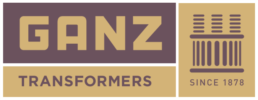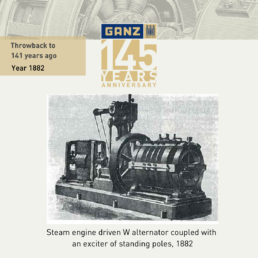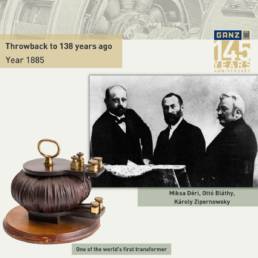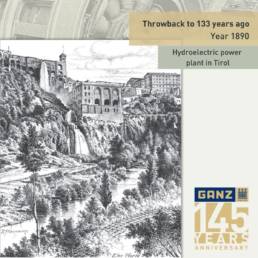145 Years Anniversary - Throwback to 145 years ago
“The first stop on the journey through Ganz’s history: 1878, the foundation of Ganz Electrical Department! Ganz was founded in 1844, under the leadership of Ábrahám Ganz, who at that time employed only 7 workers in his iron foundry in Pest. Ten years later, he launched the production of the bark-cast railway wheels and the grinding equipment for the mill industry. These first “hit products” of Mr. Ábrahám brought limelight to the name of Ganz as it has become recognized both in Hungary and internationally. Even the sudden death of the founding father, Ábrahám Ganz in 1867 did not interrupt the company’s development, as András Mechwart, the mechanical engineer of Ganz took over the management and confidently led the company – now rebranded as Ganz & Co. – towards an even higher level of recognition. In 1878, under the direction of András Mechwart, the Ganz Electric Department was established in the second district of Budapest, and it was headed by the other well-known engineer, Károly Zipernowsky. The Electrical Department first produced arc and incandescent lamps and DC dynamos, contributing the use of electricity all over Europe from the World Expositions in Paris and Vienna, the Opera Houses in Budapest and Vienna, to the street lighting in Rome. Thanks to the Electrical Department, Ganz became the heart of electricity in Central Europe. The company was also an exhibitor at the internationally renowned Sydney World Fairs in 1879 and Melbourne World Fairs in 1880. “
145 Years Anniversary - Throwback to 141 years ago
The next defining year in the life of Ganz: 1882, production of AC-generator!
As the head of the newly established Electrical Department, Károly Zipernowsky focused on running the factory and developing new designs, the economic circumstances of the early years made it necessary to expand the department. Thus, in 1882, the future director of Ganz, Miksa Déri also joined Zipernowsky’s team. Together with Miksa Déri and Károly Zipernowsky, Ganz Electrical Department developed the self-excited single phase SW type AC machines, which also functioned as a motor.
These AC-generators were powered by steam engines and used for supply of lighting systems, which is why the company advertised the products as “steam light engines”. Thanks to this brand-new invention of electricity, the lighting of the National Theatre was completed between 1882 and 1883, making it the third theatre in the world to have electric lighting. In addition, at the Vienna Electrical Exhibition in 1883, almost 1600 incandescent lamps were powered by Ganz-generators, and the first two of the famous 600HP W8-generators of the Cerchi power station in Rome, were also produced by Ganz.
145 Years Anniversary - Throwback to 138 years ago
The third stop on the journey through Ganz’s history: 1885, the year when the world’s first transformer was invented and patented by three of Ganz’s engineers.
At the time, Károly Zipernowsky, the head of our company’s electrical department, recognized the unique abilities of Ottó Bláthy, who worked as a mechanical engineer at Ganz. Thanks to his professional knowledge the expert represented the company at the 1884 National Exhibition in Turin, Italy. At the event, Ottó Bláthy encountered the secondary generator type alternating current power distribution system developed by Lucien Gaulard and John Dixon Gibbs. Bláthy noticed that the system does not use a closed iron core, and he shorted the inductor’s poles with an iron rod as a substitute. During this period, Zipernowsky was already working with Miksa Déri on a parallel connected power distribution system patented by them on 2nd January 1885. The further development of the system was boosted by Bláthy’s experience gained at the Italian exhibition, as they extended their experiments to a closed iron core design for the induction device. In March 1885, thanks to the successful experiments, the engineers of Ganz, Zipernowsky, Déri, and Bláthy invented and patented the world’s first transformer having a closed iron core with core or shell type construction, any voltage ratio and suitable for energy transmission. The patent also covered various versions of iron cores constructed from insulated iron wire and insulated iron sheet.
The transformer was presented to professionals at the National Exhibition in Budapest in 1885. The product was not recognised as a Ganz invention in several countries, even though it solved the issue of transformer-based electricity distribution and energy transmission, as well as making it possible to separate the different consumer points from each other. Despite this, in many places, including the Austro-Hungarian Monarchy or Italy, transformers manufactured by Ganz were used to a large extent.”
145 Years Anniversary - Throwback to 133 years ago
The journey through the 145-year history of our company continues: the next stop is 1890, the year when the world’s first three-phase hydrogen- generator appeared with a winding of fractional slot number of grooves! Following the invention of the closed iron-core transformer suitable for energy transmission, based on the expert opinion of the inventor of the induction motor, physicist Galileo Ferrari, the first large-scale power plant was ordered from Ganz for the city of Rome, and the unit was put into operation in October 1886. However, the ever-increasing demand required the construction of additional power plants in Rome area , and our company was chosen for this job as well The project involved connecting the 5,000 V generators of six water turbines of the hydroelectric power plant in Tivoli, 28 kilometres from Rome to the steam generators of the old Roman power plant. Thanks to this solution, the two power plants were connected by a high-voltage transmission line for the first time in the world. However, Ganz’s specialist, Ottó Bláthy, made several other key inventions, including the three-phase generator, an induction measuring instrument, similar to the “”electricity meter”” found in today’s homes. In 1890, Bláthy also won a prize at the World Exhibition in Paris for the so-called fractional slot anchor number winding used in the stator of water turbine generators. Thanks to the prize and the expansion of the Tivoli hydroelectric power station with a hydro generators, Ganz supplied largenumbers of water hydro turbine-powered generators to countries all over Europe, including Croatia and Italy and the surrounding area.”




